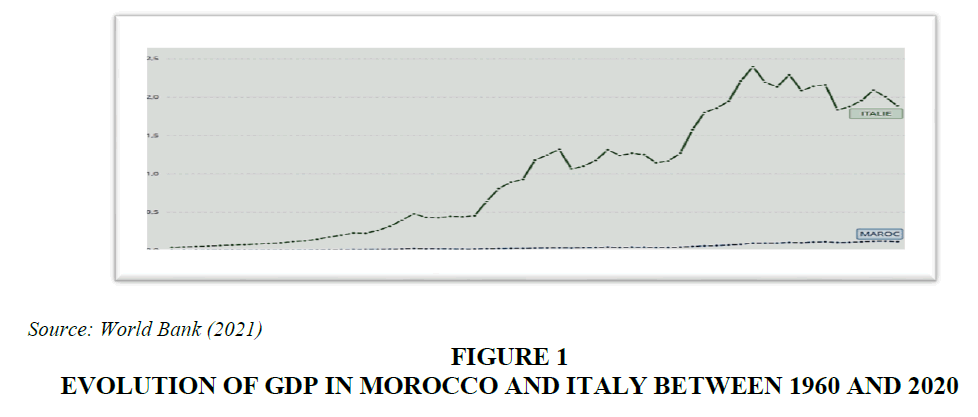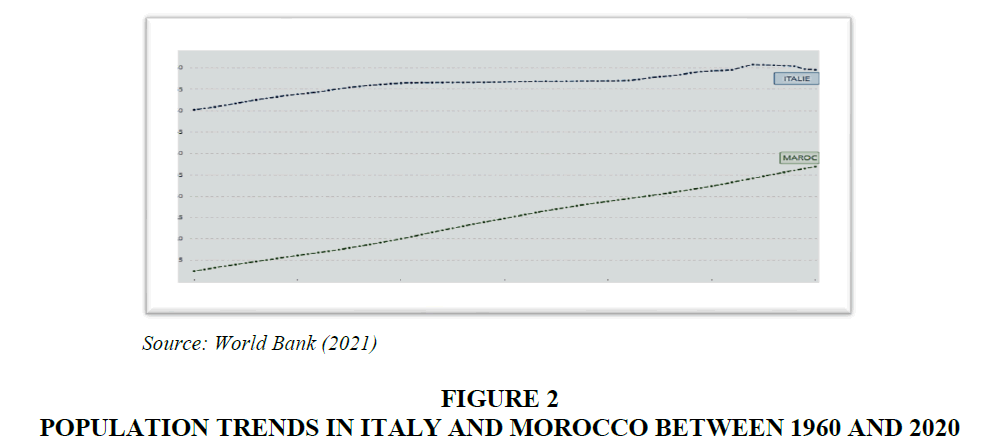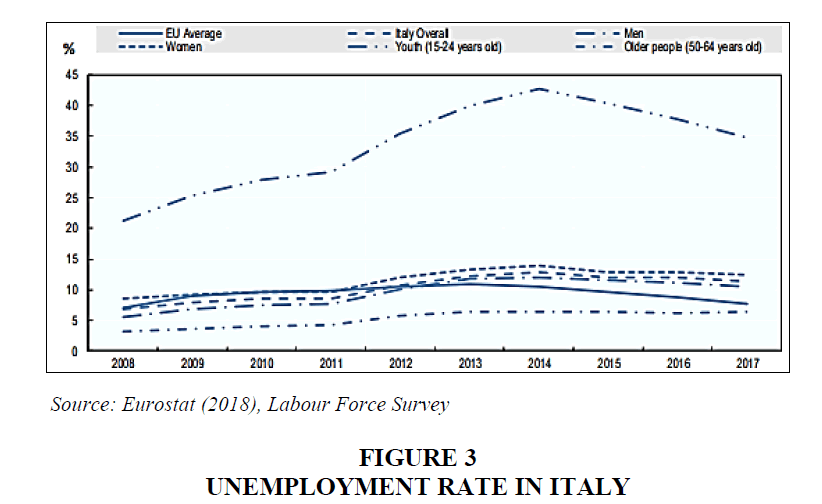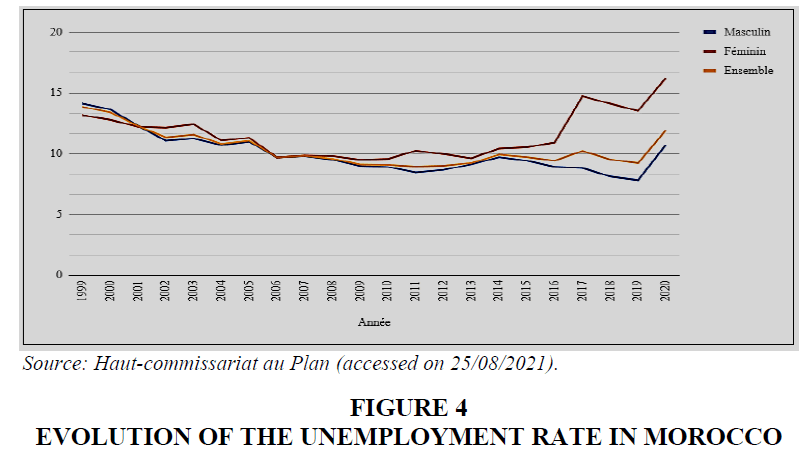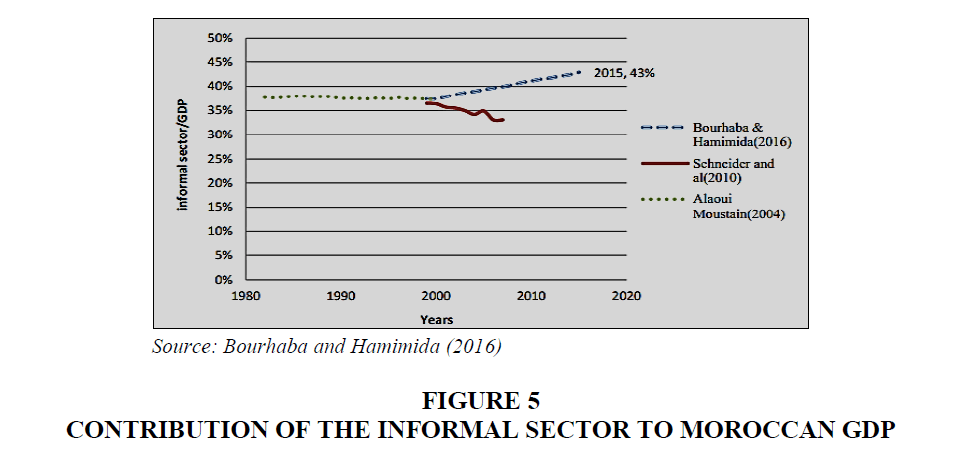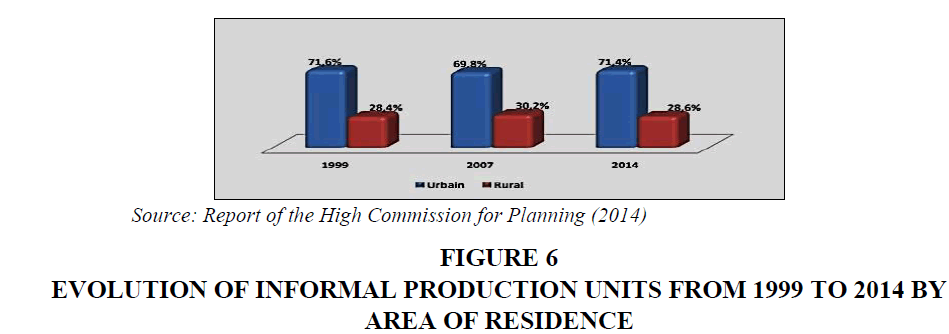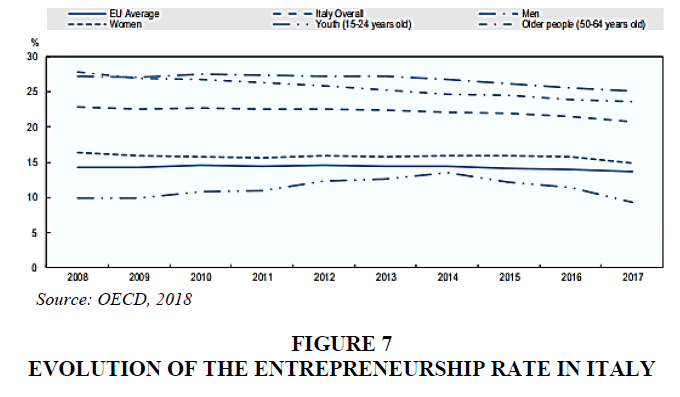Research Article: 2023 Vol: 29 Issue: 2S
The Determinants of Informal Entrepreneurship on Economies
Rania Sama, Université Ibn Tofail
Noureddine Abdelbaki, Université Ibn Tofail
Citation Information: Sama, R., & Abdelbaki, N. (2022). The determinants of informal entrepreneurship on economies comparative study between morocco and Italy. Academy of Entrepreneurship Journal, 28(S2), 1-15.
Abstract
Entrepreneurship in the informal sector is a global phenomenon of interest to management researchers. Its nature, contribution to employment and socio-economic development differ in different contexts. There is no consensus on the nature of the impact of informal entrepreneurship or on the answer to the question: "Should we ignore or fight against informality? We are interested in analyzing the determinants of this "underground economy" and its impact on entrepreneurship.
After reviewing the literature dedicated to this activity, we adopt a Benchmarking methodology for the analysis of the informal entrepreneurial phenomenon in the cases of Morocco and Italy. We base this adopted method on the exploitation of secondary data from official reports.
Our research shows that the determinants of this type of entrepreneurship are similar in both countries: the need and the attractiveness of the informal sector, especially in terms of cost reduction. We conclude that informal entrepreneurship contributes to employment and socio-economic development in both countries.
Keywords
Informal sectors, Benchmarking, Informal Entrepreneurship, Development.
Introduction
Entrepreneurship shapes changes in economic conditions in the formal and informal economy. Informal entrepreneurship has received little attention from academics, but there are reasons for this: 1) informal business activities account for a large share of global economic activity (30%). 2) informal entrepreneurship exists in all countries, regardless of their economic levels. 3) informal entrepreneurship is widespread in some countries. 4) Informal entrepreneurship is exposed to unethical practices (corruption, exploitation...). As such, it is important to understand the motivations of entrepreneurs to create new businesses in the informal sector and to study the impact of this type of entrepreneurship on the socio-economic development of countries.
Our objective is to analyze the determinants and explanatory factors of informal entrepreneurship and its impact on the level of development of the economy and the human condition. In order to better understand the phenomenon of entrepreneurship in the informal sector in Morocco, we have compared our economy and its specificities with a developed country such as Italy, characterized by the availability of information on our favorite subject. The differences between these two countries will allow us to reflect on the behavior to adopt in the face of entrepreneurship in the informal sector as well as on some ways of integrating informality in Morocco.
We have used two theories from the economic and management sciences in order to deduce some answers to our problem. The institutional theory states that institutions influence the level of development of different types of entrepreneurship, including informal entrepreneurship. The second is the eclectic theory of entrepreneurship of (Verheul et al, 2002) which states that macro and micro economic factors are determinant in entrepreneurial activity.
Our research is based on a benchmarking exercise that draws on secondary data obtained from reports and surveys published by official bodies. Our article is structured as follows: A review of the literature related to the concept of entrepreneurship and particularly the informal, key concept of our theme in a first point. The second, deals with the methodological approach followed in this study. The results drawn from this research will be analyzed and treated in a third point. The fourth point is reserved for discussion and suggestions.
Literature Review
Entrepreneurship is the creation of enterprise that stipulates the creation of wealth for several economies of countries. However, informality remains the parts of the economy that escape the formal economy; it is workers and activities that are exercised outside the formal legal and legislative framework of a country. Hence the importance of reviewing in this literature reviews the concept of entrepreneurship that has evolved with economic thinking and its position in the informal economy. We will review also, the motivations and the determinants of the entrepreneurship in the informal sector to conclude with their impact on the same sector.
Definition of Entrepreneurship in the Informal Economy
The field of entrepreneurship evolves according to different schools. Each brings an additional understanding. One of the classifications taken up in the literature is formulated by Gartner who identifies four perspectives and approaches to entrepreneurial analysis: individuals, their activities, their environment, organizational structure and strategy. Recently, (Urbano, 2014) identified three approaches to the entrepreneurial field: 1) economic; 2) psychological; 3) socio-institutional.
Classical management theories make little mention of the informal economy, which is made up of activities and entities that are not identified by the state, and where workers do not benefit from social protection. The informal economy involves monetary transactions that escape taxation. The authors have not succeeded in conceptualizing a universal definition of the concept. We will analyze several definitions in order to understand this concept, which we quote below.
According to OECD (2002): 139, it is "all legal production activities deliberately concealed from the authorities to avoid paying income, value added or other taxes; to avoid paying social security contributions; to avoid complying with certain legal standards such as minimum wage, maximum working hours, safety or health standards, etc.". For Cross (2000); the informal economy is: "The production and exchange of legal goods and services involving the absence of proper operating licenses, violation of zoning regulations, non-reporting of tax debts, non-compliance with labor regulations on contracts and working conditions, and/or the absence of legal guarantees in relationships with suppliers and customers". As for Portes et al. (1986), it is: "The sum of income-generating activities outside of modern contractual production (and distribution) relationships, which includes direct subsistence production, production of small goods and trade by self-employed people for the market and unregulated small-scale enterprises under contract to large modern enterprises". Autio & Fu (2015) define informal entrepreneur as "a person who is actively involved in running a new business selling legitimate goods and services and is not registered with official authorities".
The only illegal aspect of informality is the non-declaration of monetary transactions during the process of exchanging goods and services. The inclination of entrepreneurs towards the formal or the informal is determined by factors that we will study in the analytical part.
Informal enterprises cover a range of business activities, from street vendors selling fruit or clothes to selling household goods, but also include start-up businesses where entrepreneurs try to test the feasibility of their business ideas before incurring the sunk costs of registration and regulatory and related costs. The table below illustrates the typology of informal entrepreneurial activities according to the volume of informal activity in the overall activity of the enterprise and the time horizon of that activity shows in Table 1.
| Table 1 Entrepreneurial Typologies in the Informal Sector |
||
|---|---|---|
| Informal activity | Description | Intention to formalize |
| Total and permanent |
Operation of businesses not fully registered in the informal economy | No intention to formalize in the foreseeable future |
| Total and temporary |
Operation of unregistered businesses in a completely informal manner | An intention to formalize |
| Partial and permanent |
Exploitation of registered businesses that pay taxes but do not declare part of their income | No intention to increase reported share |
| Partial and temporary |
Registered businesses in operation that do not report a portion of their revenues | Intend to and do move into the formal economy |
Motivations and determinants of entrepreneurship in the informal sector
To understand the motivations of entrepreneurs, a distinction must be made between those driven by necessity and those driven by opportunity. Thus, it is accepted that entrepreneurs engaged in informal entrepreneurship are driven by necessity given the absence of survival alternatives. Various studies have been conducted on the factors influencing informal entrepreneurship. (Knight, 1986) suggested that individuals with poor employment prospects are elected to become self-employed in order to earn a living. According to him, individuals make choices between three activities: unemployment, self-employment and employment.
The "push" motivation is justified by the weight of unemployment, but other factors intervene to force individuals to create their own businesses.. Besides unemployment, (Giacomin, 2009) mentions autonomy and family pressure. (Sarasvathy, 2015) points out that there are different types of hapless entrepreneurs: those who are laid off, those who decide to leave their jobs because of their bosses, and those who are not hired because of lack of skills or a criminal record.
Some researchers question the separation between opportunity-driven entrepreneurship and necessity-driven entrepreneurship; although both can coexist. As a result, (Giacomin, 2009) identifies three types of motivation: market opportunity, social status and profit. While (Carter, 2000) distinguishes six categories of motivation: innovation, independence, recognition, role, economic success and personal fulfillment.
We have used two theories from economics and management sciences to derive some answers to our problem: the institutional theory and the eclectic entrepreneurship theory of (Verheul et al, 2002). Various factors contribute to informal entrepreneurship: high tax rates, low trust in government, lack of awareness of registration, burdensome regulation. On the other hand, the informal sector is flexible. Knowing that low morality is often associated with an excessive culture of informality and because of corruption in the public sector, entrepreneurs engage in informal entrepreneurship.
Institutional theory and entrepreneurship in the informal economy
Institutional theory holds that systems and institutions influence the behavior of individuals and firms without necessarily mobilizing or intervening in response to expectations (Clemens, 1999). North (1990) divided institutions into "formal institutions," such as laws, regulations and their support systems, and "informal institutions," such as social norms, values and beliefs. Formal and informal institutions define "the generalized perceptions or assumptions that the behavior of entities under these formal and informal rules is desirable, correct, or appropriate" (Suchman, 1995). By defining opportunities and facilitating interactions among actors, institutions promote socially acceptable behavior and outcomes through a system of constraints and incentives (Clemens, 1999).
The characteristics of the institutional environment influence the entrepreneurial process. Differences in the definition of social acceptability by formal and informal institutions and the degree of bureaucracy in the institutional environment can help entrepreneurs in the informal economy to identify opportunities. Weak enforcement of formal institutions, competing institutional centers, group-level institutions, and counterfeiting can facilitate the exploitation of opportunities.
The eclectic theory and entrepreneurship in the informal economy
The eclectic theory of entrepreneurship was proposed by (Verheul et al., 2002) to develop a theoretical framework representing the determinants and explanatory factors of the level of entrepreneurial development from the macro and microeconomic perspective in a country. The demand side variable is related to the entrepreneurial opportunities available to potential entrepreneurs through the industry structure and the existence of a diversified demand that are influenced by the economic development of the country.
On the supply side, individuals are the pool of potential entrepreneurs. Indeed, entrepreneurship is determined by the characteristics of the population, the participation of women and the income of individuals. Potential entrepreneurs take advantage of the right circumstances if they have the right resources, skills and preferences. Eclectic theory sees entrepreneurs as playing a role in regulating supply and demand in the economy. They take risks and respond to economic opportunities.
The following Table 2 summarizes the determinants of entrepreneurship in the informal sector.
| Table 2 Summary Of The Determinants Of Entrepreneurship In The Informal Sector |
|
|---|---|
| Determinant of entrepreneurship in the informal sector | Authors |
| Tax rates | (Schwab et al, 2015; Vanderseypen et al, 2013; Williams and Shahid, 2016) |
| Low confidence in the government | (Maloney, 2004; Packard et al, 2012; Risteski, 2009; Whitson, 2006 ; 2007) |
| Lack of awareness of registration | (McKenzie and Sakho, 2010) |
| Presence of attractive opportunities | (Perry et al, 2007) |
| Unemployment, supplementary income Independence and seizing opportunities |
(Terry & Morris et al. 1995) |
| Market exclusion | (Ram et al. 2017) (Thai, M. T. T., & Turkina, E.2014) |
| Autonomy and family pressure | (Giacomin, 2009) |
| The need | (Boyle 1994; Castells and Portes 1989; Gallin 2001; Sassen 1997) |
Source: Authors
Research Methodology
In this section, we aim to contextualize our field of study in order to understand the determinants and repercussions of informal sector entrepreneurship on economies, using a comparative study based on a review and analysis of reports.
Our methodological approach is part of a constructivist posture, where the analysis is based on a "real" perspective in order to obtain the right meaning, as an extension of the interpretivist. Identified by (Gavard-Perret, 2008), and conceptualized by (Guba & Lincoln, 1998), it will be formalized by, father of this paradigm.
The latter refers to reality as facts, intentions, values, experiences and human perceptions that are not laws of nature. Reality is based on experiences. It is "constructed" on a project. Our research is based on the benchmarking methodology, as the objective of the project is to explore entrepreneurship in the informal economy.
The choice of the "Benchmarking" method
Our research methodology consists in carrying out a benchmarking between the case of entrepreneurship in the informal sector in Morocco and that of Italy. (Codling, 1998) characterizes "benchmarking" as a continuous process of measuring and improving products, services and practices through comparison. (Spendolini, 1992) defines this concept as a continuous and systematic process of evaluating products, services and organizational processes that are recognized as best practices with the aim of improving performance. (Wong & Wong, 2019) consider it as "a management tool that is defined as a systematic process of searching for best practices, innovative ideas and efficiencies that lead to continuous improvement". Thus, the objective is to focus on the experience of the two countries in managing their informal sector and to establish the states of affairs of informal entrepreneurship by distinguishing the advantages and disadvantages in both cases.
Justification for the choice of Italy as a comparison country
The choice of benchmarking between Morocco and Italy is not random. It is motivated first of all by the existence of similarities between the two countries, including: the diversification of the economy (tourism, industry, etc.), the existence of strong regional disparities, and a similar unemployment rate. Secondly, the informal sector present in both countries contributes significantly to their GDP (11.5% for Morocco and 12.1% for Italy). Morocco and Italy provide the right terrain for understanding informal entrepreneurship, its determinants and its impacts shows in Table 3 .
| Table 3 Summary Of The Socio-Economic Indicators Of The Two Countries |
|||
|---|---|---|---|
| Indicators | Morocco | Italy | Comment |
| GDP (2019) | 119 | 2005 | The GDPs of the two countries are incomparable given the large difference in favour of Italy. |
| Population size | 36 million | 60 million | Italy's population is larger than Morocco's |
| Unemployment rate (2020) | 11,9 % | 09,98 % | Both countries have very similar and acceptable unemployment rates |
| Share of informal economy in GDP | 11,50 % | 12,1 % | The share of the informal economy in GDP of the two countries is important and very close. Despite the large difference in the levels of GDP, the informal sector contributes equally to the national wealth of both countries. |
| Volume of informal employment in total non-agricultural employment | 36,3 % | 15,5 % | Informal employment provides enormous employment opportunities in Morocco and contributes to 36% of total employment while its contribution to employment in Italy does not exceed 15.5%. |
Source: Authors' construction based on data from the World Bank, HCP, CGEM, OECD, Labour Force Survey).
Method of data collection
Our data collection method is based on the exploitation of secondary data from scientifically credible works provided by public institutions or specialized institutions (World Bank, HCP, CGEM, OECD, Labour Force Survey). In view of the limited availability of information on our subject, we have referred to data that date for the most part between 2014 and 2017.
It is from this work that we have reconstructed a new database for benchmarking purposes. The selected indicators will allow us to compare the development of the two countries: GDP, population size and unemployment level. Indicators will allow us to analyse entrepreneurship in the informal sector in Morocco: weight of the informal sector by sector of activity, number of informal production units by area, rate of increase of investment in the Moroccan informal sector. Other indicators will allow us to compare entrepreneurship in the informal sector in the two countries, we will then talk about : Share of the informal economy in GDP, volume of informal employment in total non-agricultural employment.
Presentation of Results and Data Processing
Analysis of macroeconomic indicators
GDP in Italy and Morocco
In the 1960s, the two countries were close (compared to the current situation) in terms of GDP value with a small superiority in favor of Italy. The latter saw its GDP increase cofnsiderably to reach its maximum of about 2399 billion dollars in 2008 and which reached 2005 billion dollars in 2019, contrary to Morocco whose GDP increases regularly, but with a very poor growth rate to reach its maximum level in 2019 with a GDP value that amounts to 119 billion dollars. The figure below shows the remarkable difference in the evolution of the GDP of Morocco and that of Italy shows in Figure 1.
Population size in Italy and Morocco
The population size of both countries has continued to evolve since the 1960s with a high growth rate in the Moroccan case compared to that of Italy. Currently, the total population of Morocco is around 36 million, while that of Italy is 59 million.
The Figure 2 below shows the evolution of the two countries in terms of population size and illustrates a notable upward trend.
Unemployment in Italy and Morocco
The unemployment rate in Italy has been rising continuously since 2008. It has exceeded the EU average level since 2012. This rate is higher for women. In general, the unemployment rate has continued to decline in Italy to 09.98% in 2020 compared to 11.9 for Morocco shows in Figure 3.
The unemployment rate in Morocco has recorded a considerable decrease since the beginning of the century until 2019, followed by a sharp increase among men or women. This rate has dropped from 13.8% in 1999 to 11.9% in 2020. However, the rate for women remains high at around 16.2%, while for men it does not exceed 10.7%.
The figure above shows the evolution of the unemployment rate in Morocco and Italy. In 2020, the unemployment rate decreased remarkably in Italy to reach 09.98% against 11.9% for Morocco shows in Figure 4..
Analysis of studies on informal entrepreneurship in Morocco and Italy
Informal entrepreneurship in Morocco
In Morocco, the informal sector is a component of the country's economy. According to a recent survey conducted by the High Commission for Planning, it accounts for nearly 36.3 per cent of total non-agricultural employment and contributes 11.50 per cent of the country's gross domestic product (GDP), compared to only 11 per cent in 2007 shows in Figure 5.
Several studies have highlighted the informal sector in Morocco. Three are worth highlighting:
1) The widely cited Schneider study that examined the size of the informal economy in 162 countries between 1999 and 2007. The study used the Multiple Indicators Multiple Causes Model (MIMIC) methodology and estimated the size of informality in the GDP of these countries at 37%.
2) Alaoui Moustain's study which used the MIMIC (multiple indicators multiple causes model) methodology covering the period 1975 to 2000. Alaoui Moustain found that in 1998, the Moroccan informal sector was the largest in the world. The informal economy accounted for 38% of GDP Moustain (2004).
3) The study by Elgin and Oztunali focused on a dynamic equilibrium model to calculate the size of the informal economy in 161 countries between 1950 and 2009. It found that the size of the informal sector in Morocco was 36% of GDP in 1999. All estimates are in the range of 35-40% of GDP.
Evolution of informal production units in Morocco
Informal production units located in rural areas accounted for 28.6% in 2014 compared to 71.4% in urban areas. Indeed, the number of informal work units increased from 1.23 million units in 1999 to 1.55 million units in 2007, reaching 1.68 million units in 2013. The vast majority are located in urban areas, with a proportion of around 71.4%. One in five businesses is located in the "Casablanca-Settat" region, which accounts for 19.2% of informal businesses in Morocco. If we add Rabat-Salé-Kénitra (15.9%) and Marrakech-Safi (13.2%), half of the informal work units are located in these three regions shows in Figure 6.
Informal entrepreneurship and employment in Morocco
Non-farm informal employment in 2013 reached a total of 2,373,940 jobs; 36.3 percent of the volume of non-farm employment. The trade sector alone controlled 47% of jobs in 2014. Thus, we find that informal entrepreneurship contributes significantly to employment in Morocco.
The informal economy is a provider of financial resources and a vector for the development of living conditions. In 2015, more than 2.9 million people, or 59.2% of the working population, were living on income from informal employment (National Employment Survey, 2015). These populations also enjoy considerable gains in terms of economic employment and relative protection from unemployment shows in Table 4.
| Table 4 Contribution Of The Informal Sector To Employment In Morocco |
||||||||||
|---|---|---|---|---|---|---|---|---|---|---|
| 2007 | 2014 | |||||||||
| Construction | Commerce | Industrie | Services | Total | Construction | Commerce | Industrie | Services | Total | |
| Volume of employment in the informal sector | 142 936 | 1 128 852 | 475 451 | 468 877 | 2 216 116 | 209 447 | 1 114 772 | 476 629 | 572 091 | 2 372 940 |
| Volume of employment in the informal sector in % | 6,4 | 50,9 | 21,5 | 21,2 | 100 | 8,8 | 47 | 20,1 | 24,1 | 100 |
| Share of informal sector employment in total non-agricultural employment in % | 17 | 81,1 | 34,5 | 18,6 | 37,3 | 21,4 | 68,5 | 37,2 | 21,5 | 36,3 |
The weight of the informal sector by sector of activity:
At the macroeconomic level, the informal economy in Morocco is present in each sector of the national economy to a different degree. It constitutes 54% of the textile and clothing sector, 32% of the road transport sector, 31% of the construction sector and 26% of the agri-food sector. As a result, the impact of informal entrepreneurship is felt in several ways. According to CGEM (2018), this translates into lost earnings for many actors.
• The informal economy has cost the State a loss of revenue of 40 million MAD;
• Formal enterprises are losing financial profitability due to the decrease in turnover.
• The customers are harmed by the lack of respect for the regulations in force.
Determinants of entrepreneurship in the informal sector in Morocco:
The survey conducted by the HCP on informal entrepreneurship reveals the determinants and explanatory factors that are the need to meet the needs of life (25%), the desire to obtain a better income (22.8%), the search for independence (18.3%), a remedy for unemployment (13.6%). These results corroborate our theoretical findings from our literature review on the question of the determinants of informal entrepreneurship.
Informal entrepreneurship in Italy
In 2017, the unobserved economy amounted to 211 billion euros; or 12.1% of GDP. The underground economy amounted to less than 192 billion euros and illegal activities to about 19 billion. The estimates for 2017 confirm the downward trend in the GDP impact of the unobserved component of the economy after the peak in 2014 (13.0%). Informal work units in 2017 numbered 3.7 million, up by 25,000 units from 2016. With the recent revision of the accounts in Italy, decided at the European level, and five years after the changeover to ESA 2010, the methodology for estimating informality has been revised for the entire 2011-2017 historical series. The new methodological framework introducing methodological advances in statistical models is in line with the recommendations of the European Commission on the treatment of VAT fraud.
The latter type of integration contains an unidentifiable proportion of effects related to purely statistical phenomena, or attributable to the existence of the underground economy not captured by the estimation of underreporting and irregular work. Illegal activities are the production of goods and services whose sale, distribution or possession is prohibited by law, and legal ones are carried out by unauthorized operators. In 2017, the value added generated by the unobserved economy stood at just under 211 billion euros (from 207.7 billion euros in 2016); an increase of 1.5% compared to the previous year, marking a slower dynamic than the overall value added, which increased by 2.3%.
Evolution of the level of entrepreneurship in Italy
The ratio of self-employed has decreased little over the last ten years. In 2008, 22.9% of the working population was self-employed. In 2017, it was 20.8%. This decrease is observed among self-employed men and women, among young people and seniors. The largest decline was among those aged 50 to 64; the self-employment rate fell from 27.8% in 2008 to 23.6% in 2017. Note a gender gap in entrepreneurship. In 2017, men were more self-employed than women (25.2% and 14.9%) shows in Figure 7.
Evolution of the volume of the informal sector in Italy
Italy has reduced its informal economy by 9% in 9 years. In 2017, the informal economy generated a value added of 211 billion euros (207.7 billion in 2016), an increase of 1.5%. A slower growth than the total value added (+2.3%).
The weight of the informal and illegal economy on GDP decreased from 12.2% in 2016 to 12.01% in 2017, confirming the downward trend since the peak reached in 2014 (13%). The decrease compared to 2016 is due to the reduction in the weight of the component referring to the underground economy (from 11.2% to 11.1%), while the incidence of the illegal economy remains stable (1.1%).
Formal and informal entrepreneurship in Italy
A comparison between the numbers of companies created in the European Union and the OECD countries shows that the rate of creation of start-ups and informal business is higher than the rate of creation of formal companies. In Italy, the increase in the volume of informal businesses created can be justified by several factors, including cumbersome administrative and legal procedures, the search for flexibility, and cost reduction.
The impact of informal entrepreneurship on the economy is twofold, as informal enterprises are both a source of unfair competition for the formal sector and a source of livelihood for the unemployed. Informal entrepreneurs benefit most from their underground activities. They generate additional profits through tax evasion and reduced set-up costs, and enjoy more flexible working conditions. Some of these benefits are more important for socially disadvantaged groups.
Summary of Results and Suggestions
Beyond the figures, the laissez-faire attitude of the informal sector, which accounts for a large part of the national GDP and provides a living for thousands of people, has led to the emergence of a kind of entrepreneurship. These actors believe that they have a right just like the operators. However, these precarious activities are useful to the community, and prohibiting them would mean exclusion and a source of social problems.
In this environment, the legal system that encourages some to break the law while penalizing others, inevitably loses its prestige with both", thereby weakening the legal apparatus and allowing for laxity and even corruption on the part of the authorities on the ground. This political status quo makes all the interactants live with it, because they find a financial advantage in it. As a result, the strategy of the "carrot and stick" policy can only lead to exclusion, because the state loses its legitimacy when the authorities on the ground have neither the means nor the desire to fight against the informal sector, or even participate in it.
Integrating order (social contract) into the laws by integrating their ways and modes of organization requires official recognition of the informal mode of working which is a functioning social order. These actors involved in informality should be more organized so that the public authorities are able to recognize their organizations and better understand their functioning and aspirations. It is important to take into consideration that informal activity is organized in a social order and that its actors only want to be integrated or recognized and to participate in the real economy of the country. The solution is therefore not simple and we do not formulate solutions. But this process requires the recognition and integration of extralegal properties into the legal system. In this respect, the example of the regularization of so-called "informal" situations in the land sector is a successful experience, because this integration has boosted the economy.
It is up to governments to convince individuals in "extralegal informality" that they will benefit from joining the national formal system rather than remain at the mercy of local arrangements. In this respect, transparency and simplification of administrative procedures would be important.
Establishing a minimum level of recognition would make it possible to better address young people without qualifications. In this respect, the policy of developing vocational training as a lever for territorial development via the “Cités des Métiers et des Compétences”(Cities of Trades and Skills) providing training leading to a diploma is a first step.
Similarly, the generalization of social protection defined by the draft framework law 09.21 on social protection will enable millions of Moroccans to benefit from compulsory medical coverage, compensation for loss of employment, family allowances, harmonization of pension schemes, etc.
Therefore, "if entering into legality has a cost, remaining outside necessarily has a cost as well". It is in the sense of this balance that the State must act through a transparent policy that will allow these actors to perceive their interests in progressively legalizing their activities.
Conclusion
There is a big difference between the economic level of Morocco and that of Italy. In fact, Morocco's gross domestic product is 16 times lower than Italy's. The comparative analysis of informal entrepreneurship between Morocco and Italy has shown that there are many similarities. Indeed, the weight of entrepreneurship in both countries is considerable. It represents about 11% (HCP, 2020) of GDP for Morocco and 12% (ISTAT, 2020) of GDP for Italy. Similarly, the contribution of the informal sector to the creation of employment opportunities for citizens is very important, especially in the Moroccan context, since the informal sector employs about 36% of the total active population, whereas in Italy the informal sector employs about 15.5% of the population. Thus, the contribution of informal entrepreneurship remains very important in both countries despite the fact that they are very different in terms of socio-economic development. However, the informal sector provides a lot of benefits, especially in terms of economic development and job creation.
There are no two opinions on informal entrepreneurial activities; they are condemned on all platforms and in all societies. In reality, informal entrepreneurship is present in all societies and in all parts of the world. The objective of our research was to analyze the determinants and motivations that drive entrepreneurs to the informal sector as well as to study the main impacts of this type of entrepreneurship on the socio-economic development of countries.
Indeed, our analysis allowed us to deduce that the main determinants of informal entrepreneurship are divided into two categories: the first integrates the factors of need, necessity and obligation, i.e. a "Push" category, while the second category includes factors relating to the attractiveness of the informal sector, which is notably linked to the reduction of costs, escape of taxes, etc.
Our benchmarking research between the Moroccan and Italian cases on informal entrepreneurship has led us to the following findings:
• Informal entrepreneurship is considerably present in both countries;
• The determinants of informal entrepreneurship are mainly need, necessity, and an alternative strategy for survival;
• The informal sector contributes significantly to the GDP of both countries in a similar way (11% for Morocco and 12% for Italy);
• Informal entrepreneurship contributes considerably to the creation of employment opportunities in both countries (36% for Morocco and 15% for Italy);
• The limitations of informal entrepreneurship are mainly related to risk, uncertainty and lack of social security and instability of demand, etc.
In summary, we emphasize that informal entrepreneurship offers several advantages to countries, allowing them to improve their socio-economic performance. However, it also has negative repercussions for the people who operate in it. Thus, it is necessary to think about setting up mechanisms and strategies aiming at the integration of informal entrepreneurship in the formal sector in order to benefit from it without suffering from its negative effects.
References
Autio, E. & Fu, E. (2015). Economic and political institutions and entry into formal and informal entre-preneurship. Asia Pacific Journal of Management, 32(1), 67-94.
Boyle, E. (1994). The rise of reluctant entrepreneurs. International Small Business Journal, 12(2), 63-69.
North, C.D. (1990). Institutions, institutional change and economic performance. Cambridge University Press.
Carter. A. (2000). Improving the numbers and performance of women-owned businesses: Some implications for training and advisory services. Education & Training, 42.
Indexed at, Google Scholar, Cross Ref
Castells, M.A. (1989). World underneath: The origins, dynamics and effects of the informal economy. John Hopkins University Press.
CGEM. (2018). National Report.
Clemens, E.S. (1999). Politics and institutionalism: Explaining durability and change. Annual Review of Sociology, 25, 66-441.
Codling, S. (1998). Benchmarking, Gower.
Cross, J. (2000). Street vendors, modernity and postmodernity: Conflict and compromise in the global economy. International Journal of Sociology and Social Policy, 20(1), 29-51.
Eurostat, A. (2018). Labour Force Survey.
Gallin, D. (2001). Proposals on trade unions and informal employment in time of globalization. Antipode.
Gavard-Perret, M.L.(2008). Méthodologie de la Recherche - Réussir son mémoire ou sa thèse en sciences gestion. Paris: Pearson Education France.
Giacomin, O.G.(2009). Necessity and opportunity creation motives and sectors of creation. Discussion papers (29506), 18.
Guba, E. (1998). Competing paradigms in qualitative research, in The landscape of qualitative research. London: Sage.
Hamimida, B.A. (2016). An Estimation of the Informal Economy in Morocco. International Journal of Economics and Finance.
Knight, G. (1986). Correlates of informal grievance resolution among Fist-Line Supervisors. Industrial Relations / Relations industrielles.
Indexed at, Google Scholar, Cross Ref
Maloney, W. (2004). Informality revisited. World Development, 32(7), 1159-1178.
McKenzie, D.S. (2010). Does it pay firms to register for taxes? The impact of formality on firm probability. Journal of Development Economics, 91(1), 15-24.
Moustain, F.Z. (2004). Market distortions and the informal economy: the case of Morocco,". Lancaster University Management School, Economics Department.
Oztunali, C.E. (2012). Shadow Economies around the World: Model Based Estimates. Working Papers 2012/05, Bogazici University, Department of Economics.
Packard, T.G. (2012). In from the Shadow: Integrating Europe's Informal Labor. The World Bank.
Perry, G.E., Maloney, W.F., Arias, O.S., Fajnzylber, P., Mason, A.D., & Saavedra-Chanduvi, J. (2007). Informality: Exit and Exclusion. Washington, DC: World Bank Latin American and Caribbean Studies.
Piaget, J. (2011). Piaget constructivism intelligence. Presses universitaires du Septentrion.
Portes, A. (1987). Making it underground: Comparative material on the informal sector in Western Market Economies. American Journal of Sociology, 93(1), 30-61.
Risteski, H. (2009). Assessing handicraft shadow economy in Macedonia. Center for Economic Analyses.
Sarasvathy, S.D. (2015). Great Authors in Entrepreneurship and SMEs. EMS Editions.
Sassen, S. (1997). Informalisation in Advanced Market Economies. ILO, (p. 20). Geneva.
Schneider, F.B. (2010). Shadow Economies All over the World New Estimates for 162 Countries from 1999 to 2007. Policy Research Working.
Schwab, M.O.W. (2015). The window tax: A case study in Excess Burden. Journal of Economic Perspectives, 163-80.
Spendolini, M.J. (1992). The Benchmarking Book. 1992: Amacon.
Suchman, M.C. (1995). Managing legitimacy: Strategic and institutional approaches. The academy of Management Review, 20(3), 571-610.
Terry, W., & Morris, E.M. (1995). Relationship between intelligence and occupational adjustment and functioning. Journal of Counseling & Development.
Thai, M.T. (2014). Macro-level determinants of formal entrepreneurship versus informal entrepreneurship. Journal of Business Venturing, 29(4), 490-510.
Indexed at, Google Scholar, Cross Ref
Urbano, C.A. (2014). Institutional dimensions and entrepreneurial activity: an international study. Small Business Economics, 42.
Indexed at, Google Scholar, Cross Ref
Vanderseypen, G.T. (2013). Undeclared work: recent developments. in European Commission (ed.). Employment and Social Developments in Europe, 74-231.
Verheul, I.W.S. (2002). An eclectic theory of entrepreneurship: Policies, Institutions and Culture. Boston/Dordrecht: Kluwer Academic Publishers.
Whitson, M. L. (2006). The relationship of ethnic identity and gender role attitudes to the development of career choice goals among black and Latina girls. Journal of Counseling Psychology, 53(3), 379-385.
Indexed at, Google Scholar, Cross Ref
Whitson, R. (2007). Hidden struggles: Spaces of power and resistance in informal work in urban Argentina. Environment and Planning A, 39(10), 2916-2934.
Williams, C.C. (2016). Informal entrepreneurship and institutional theory: Explaining the varying degrees of (in)formalization of entrepreneurs in Pakistan. Entrepreneurship and Regional Development, 28, 1-25.
Wong, L. (2019). Benchmark consolidated results against experimental data from SPERT IV statics.
Received: 05-Dec-2022, Manuscript No. AEJ-22-12944; Editor assigned: 07-Dec-2022, PreQC No. AEJ-22-12944(PQ); Reviewed: 19- Dec-2022, QC No. AEJ-22-12944; Revised: 26-Dec-2022, Manuscript No. AEJ-22-12944(R); Published: 28-Dec-2022
